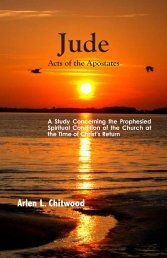Signs in John's Gospel - The Lamp Broadcast
Signs in John's Gospel - The Lamp Broadcast
Signs in John's Gospel - The Lamp Broadcast
Create successful ePaper yourself
Turn your PDF publications into a flip-book with our unique Google optimized e-Paper software.
206 SIGNS IN JOHN’S GOSPEL<br />
<strong>The</strong>n several decades later — dur<strong>in</strong>g the period covered by<br />
the Book of Acts, dur<strong>in</strong>g the reoffer of the k<strong>in</strong>gdom of the heavens<br />
to the Jewish people (which lasted from 33 A.D. to about 62<br />
A.D.) — the Spirit of God s<strong>in</strong>gled out eight signs (from among all<br />
the signs which Jesus had performed) and moved John to record<br />
them <strong>in</strong> his gospel. And the purpose for the Spirit mov<strong>in</strong>g John<br />
to record these eight particular signs is given near the conclusion<br />
of his gospel, <strong>in</strong> John 20:30, 31.<br />
<strong>The</strong>se eight signs, form<strong>in</strong>g a framework around which John’s<br />
gospel is built, were recorded for exactly the same purpose that they<br />
were orig<strong>in</strong>ally performed:<br />
<strong>The</strong>y were orig<strong>in</strong>ally performed to effect belief among the<br />
Jewish people dur<strong>in</strong>g the offer of the k<strong>in</strong>gdom of the heavens, dur<strong>in</strong>g<br />
Christ’s earthly m<strong>in</strong>istry, as recorded <strong>in</strong> the gospel accounts.<br />
<strong>The</strong>y were recorded <strong>in</strong> John’s gospel to effect belief among<br />
the Jewish people dur<strong>in</strong>g the reoffer of the k<strong>in</strong>gdom of the heavens,<br />
dur<strong>in</strong>g the m<strong>in</strong>istry of the apostles, as recorded <strong>in</strong> the<br />
Book of Acts.<br />
This is the reason why, <strong>in</strong> the Book of Acts — <strong>in</strong> l<strong>in</strong>e with Rom.<br />
1:16; 2:9, 10 — the apostles and others always, without exception,<br />
went ”to the Jew first” <strong>in</strong> every locality where the message was<br />
proclaimed. It was only after the message had been proclaimed<br />
to the Jews <strong>in</strong> a particular locality (<strong>in</strong>variably followed by rejection)<br />
that those proclaim<strong>in</strong>g the message were free to go to the<br />
Gentiles <strong>in</strong> that same locality with the same message concern<strong>in</strong>g<br />
the k<strong>in</strong>gdom, though “an offer” of the k<strong>in</strong>gdom, not “a reoffer”<br />
(which, of necessity, because of the message, could only have been<br />
“an offer” of the k<strong>in</strong>gdom to saved Gentiles).<br />
This is also the reason why one can know that the <strong>Gospel</strong> of<br />
John — recorded to effect belief among the Jewish people relative to<br />
Christ and the proffered k<strong>in</strong>gdom — was written at a time before<br />
the close of the reoffer of the k<strong>in</strong>gdom of the heavens to Israel,<br />
sometime before about 62 A.D.<br />
More often than not a late date is assigned to the writ<strong>in</strong>g of<br />
John’s gospel (usually between about 85-95 A.D.). However, no<br />
valid reason exists for this late date. And, not surpris<strong>in</strong>gly, many



